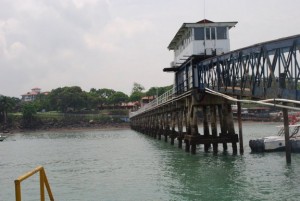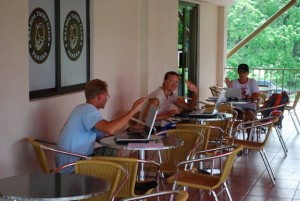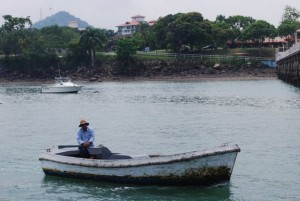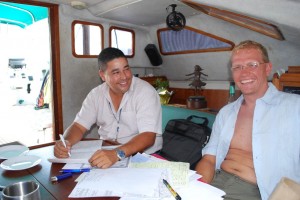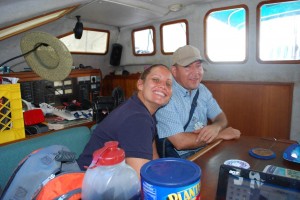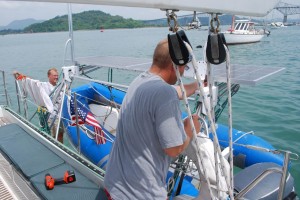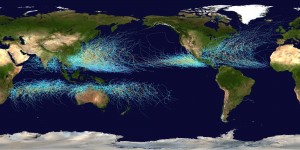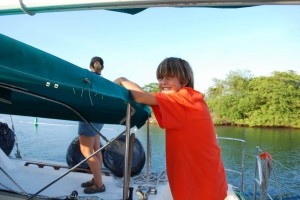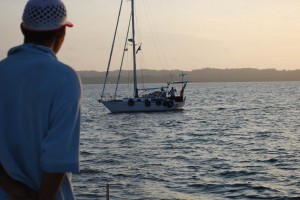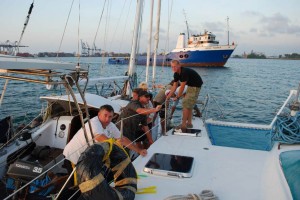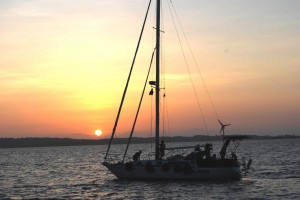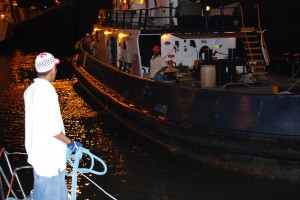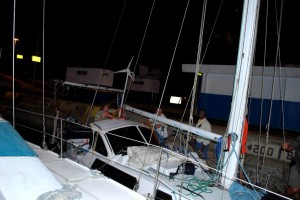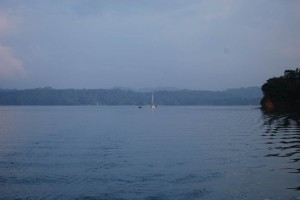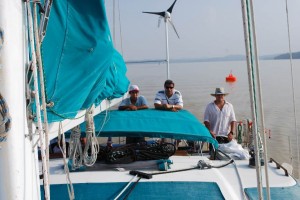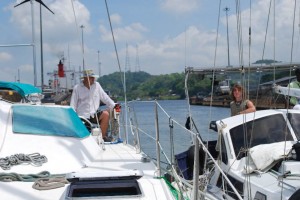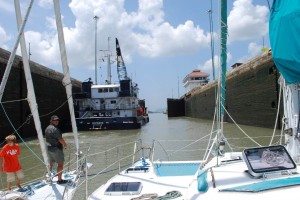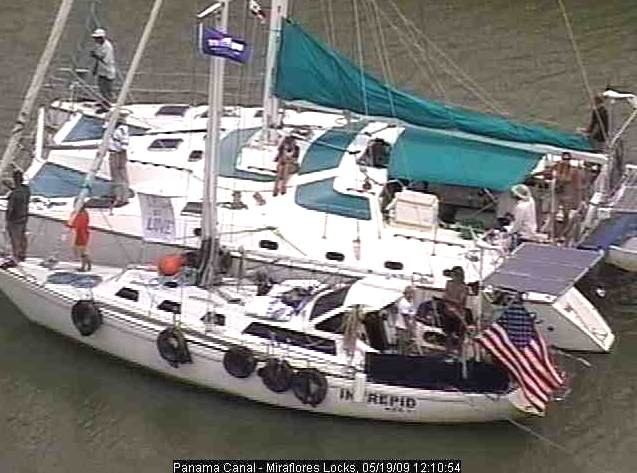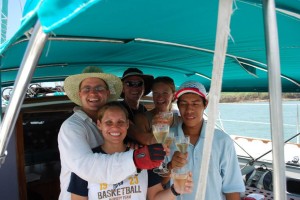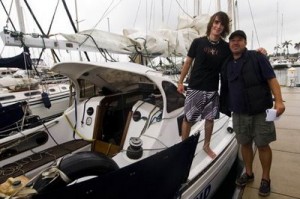The showers very seldom have hot water (I’ve experienced it once, but I don’t think anyone else has). I remember reading on-line in the cruising forums before we left about the various ways to install a hot water system on boats. One person posted that if your cruising grounds were the tropics, a hot water system was just a waste of time, money, and space — nobody wants a hot shower in the tropics. He was pretty much right. The first cold shower I took actually wasn’t cold enough. I kept thinking I’d get out when I still felt nice and cool after sticking my head out of the cool water, but it never happened. You eventually start to adjust to the heat and humidity, but I’m still not quite used to the boat being so damp all the time. It’s funny, but the cold showers are actually sort of a luxury.
There’s a TGIFriday’s across the parking lot with air-conditioning and a menu almost identical to the one in the states. The service is quite a bit different, though. They’re pretty laid-back and don’t mind you hanging out to watch a playoff game or just enjoy the air-conditioning and free Internet for the afternoon. It’s not exactly a cultural experience, but the broccoli and cheese soup is good.
We’ve noticed that a few of the cruisers that we met at Shelter Bay have made it across the canal and are now here, but so far the only other cruisers we’ve been hanging out with are Zac Sunderland and his crew, as there’s no easy and obvious place to congregate. On Friday night we went out in Panama City with Zac. Since we know nothing about Panama City, we looked at one of the local tourist books, noticed that several of the discotheques were on a street called Calle Uruguay, so thought we might as well try it. It was pretty similar to an upscale downtown nightlife district in the US with clubs, bars, and some great fare from street vendors who had setup food stands on the sidewalks.
We’ve been here long enough that we’ve been able to see the transition into the rainy season. The days are all pretty similar now — generally cloudy although sometimes a little sunny in the morning and rain every afternoon that’s starting to become pretty heavy. The rain lasts an hour or two and so far hasn’t rained in the morning or at night.
We would have left this weekend, but we were waiting to finish up our boat insurance for the Pacific crossing. Although things didn’t get finished before the weekend, our insurer did respond to e-mails today and we’re pretty much done. We should be able to leave for Las Perlas in the next day or two. We’re hoping to have a day or two of good diving and pretty anchorages there before we head for the Galapagos. We’re expecting the crossing to the Galapagos to have a lot of light and/or contrary winds, but once we get close, we should have some great tradewind sailing until we leave Fiji.
Wednesday was yet another great day. It started out a little rushed, as Dallas was concerned that we would not have time to visit the port authority office as well as the French Embassy by noon when the woman responsible for visas finishes work. (A 20-hour work week seems quite cushy even for the French!) However, just after we finished breakfast, two men from the port authority office arrived to clear us in, saving us the hassle of making the trip to their office. The men were very amiable and seemed pleased that we had our paperwork in order and that Dallas and Wes could converse with them in Spanish.
Then it was on to Panama City via the free water taxi and $5 cab. Initially we drove through a poorer area of town as evidenced by the run-down condition of the homes and buildings, but it was clearly more orderly than Colon–no one walked in front of the cab, there were traffic signals, and I don’t remember seeing graffiti/airbrushing all over the place. We then found ourselves in an old but very well maintained district (el Casco Antiguo) with Spanish architecture, flowers hanging from balconies, and historic monuments. This was the most aesthetically pleasing place that I had seen since Old Town in Key West, and I welcomed the change of scenery.
As we got out and proceeded into the French Embassy, I mentally prepared to state what we needed in French, but as it turns out, the staff spoke English rather well. After waiting in the air conditioned waiting room for 20 minutes using the embassy’s reading materials to brush up on my French, we learned that it could take as long as 2 weeks to get an extension for our 30-day tourist visa for French Polynesia. We don’t have that kind of time to wait, so we will just have to find a way to get to Tahiti to obtain an extension (or prolongation, as the woman at the embassy called it) before our 30 days are up. We will most likely catch a plane or charter boat to Tahiti and back to our boat rather than sailing there, as everything we have heard suggests that we are going to want to spend much more than 30 days in the Marquesas, the easternmost island group of French Polynesia.
Upon leaving the embassy, we walked around for a bit looking for an internet cafe. We stopped in a convenience store for some bottled water, and Wes surprised us with ice cream sandwiches–a very nice treat. After asking several people, all of whom were friendly, we found our way to the internet cafe near Santa Ana Plaza. Wes and Tiff located their next destination, a store that sold a specific cable that Wes needed for his computer. Dallas and I opted to explore the area a bit and located a store that will be perfect for final provisioning. It is very similar to Walmart with the exception of a section called “Esoterica” that contained various soaps and lotions designed for enhancing one’s fortune or sex life (souvenirs, anyone?).
We then headed back toward the historical area and found ourselves at el Museo del Canal Interoceanica. We were told that the displays were all in Spanish but stopped in anyway since it was only $2/person. Three hours later, we had learned quite a lot about the history of the Panama Canal! Dallas managed to translate almost all of the key points for me (so we think), and the pictorial exhibits helped to convey the story as well. In a nutshell, international interest in the isthmus of Panama dates back to the 1500’s as a result of its geographical location and potential to greatly expand global commerce. Initially (circa 1855), an American company created a railroad that extended across the isthmus, providing another means for ’49ers to travel to California. However, it was not ideal for commerce, and thus, discussions continued regarding where to dig a canal. The American engineers apparently favored a route across the 200+ mile stretch between Columbia and Nicaragua, as there was a large lake there already. However, the Frenchman Ferdinand de Lesepps, who was credited with the creation of the Suez Canal, preferred the short (33 mile) Panamanian route and used his credibility and bravado to convince other French companies to buy in.
Digging began in 1880 without sufficient study of the geology of the region. There were serious, unanticipated problems right off the bat. Clearing the jungle was extremely labor intensive. Further, workers began to perish as a result of diseases such as malaria, which they did not realize was carried by mosquitoes. De Lesepps did not reveal these difficulties to his funders, however, until they had lost over 20,000 workers and had no choice but to abandon the project.
American companies took over at the turn of the century and were able to address the medical problems plaguing the canal workers. The project became political in 1903 when the Panamanians requested help from the U.S. in order to gain independence from Columbia. The Americans agreed to assist with the U.S. Navy for a price…possession of the Canal Zone when completed. Over the next 10 years, Americans sent over 7,000 men and women to the Canal Zone to work alongside Panamanians, Europeans, and Africans from the Caribbean region to complete the project. (This explains the racial diversity that exists here today.) Enough land was dug out of the canal to create 63 Egyptian pyramids or a pave a track around the world three times!
While this may sound like cause for good relations between the U.S. and Panama, the exhibits revealed that there was anti-American sentiment for a couple of reasons. First, the Americans working on the Canal were termed the “Gold Class” as they had nicer accomodations, better salaries, and more amenities than the “Silver Class” (everyone else). Second, the Americans had a military presence in the Canal Zone to protect their possession of the area and established their own laws and courts that gave them the right to expel people from the area. Panamanians began to organize demonstrations against the American occupation in the late 1940’s, and these continued and became more violent until the 1970’s when President Johnson made some concessions in terms of voiding the 1903 treaty and allowing Panamanians to share control of the Zone. The Canal Zone was returned to Panama in 1999, but to me, the influence of American culture still remains in terms of gender equality (e.g., we saw as many female police officers as male ones that first day in Colon) and entrepreneurial spirit (e.g., our advisor for the Canal transit told me that he wanted to start a bottled water company).
Dallas and I were pleased that it had stopped raining by the time we left the museum and popped into a souvenir shop to get a couple of crafts made by the nearby Kuna Indian tribe. We then explored our options for dinner and settled on an open-air restaurant called Buzio’s that played really good Brazilian music. All of the food was excellent, and Dallas the vegetarian was enticed to sample my red snapper with mediterranean vegetable sauce, which he seemed to really like!
We headed back to the Balboa Yacht Club where the boat is moored and found Zac and his entourage there at the restaurant. There were 10 minutes left before happy hour ended (this seems to be a global phenomenon), so we ordered a couple of pitchers of the local Balboa beer (pretty good) and enjoyed some more great conversation. Zac had to leave at one point to skype with a reporter from CNN (http://ac360.blogs.ncc.com/2009/05/21/sailing-around-the-globe). He stays pretty busy while in port!
As I’m sure you can tell, we are really enjoying this side of Panama. It feels great to be in the Pacific, as if we have accomplished something. In actuality, we have only traversed about 5% of the world, though, so we have a long way to go! We are planning to stay here for just a couple more days before heading to the Las Perlas for a day of scuba diving. Dallas was pretty sick yesterday but seems to be doing much better today, as he and Wes have already managed to install the two new solar panels that were delivered to us here in Balboa. Tiffany and I are trying to talk them into visiting the local discoteca tonight…we’ll let you know how that goes!
The Atlantic hurricane season is officially from June to November. That means that 97% of all storms have occurred during that time period.
Note that no storms have made it as far south as Colon or Panama City.
The Atlantic basin has a very peaked season from August to through October.
The next area we have to worry about is the South Pacific.
The Australian/Southwest Pacific basin begin with tropical cyclone activity in late October/early November, reaches a single peak in late February/early March, and then fades out in early May.
Our goal is to be in New Zealand before the beginning of this storm season, well south and out of the way of storms. There have been two storms in the last ten years that have crossed New Zealand, but we will be tucked away safe in harbor.
We plan to leave New Zealand next May and head on through the Torres Straits and through the Indian Ocean. The next storm season is about the same as the last, so we will be trying to get out of that zone by October.
The Southwest Indian and Australian/Southeast Indian basins have very similar annual cycles with tropical cyclones beginning in late October/early November, reaching a double peak in activity – one in mid-January and one in mid-February to early March, and then ending in May. The Australian/Southeast Indian basin February lull in activity is a bit more pronounced than the Southwest Indian basin’s lull.
That is the world storm seasons in a nutshell. I hope that answers some of the questions people have had.
Sorry for the late blog update, but we’ve been having a great time ever since we left Shelter Bay. We left the marina just after Intrepid at about 17:30 on Monday to meet so that we would have plenty of time to get to the flats (anchorage area F in Limon Bay) where our advisors were scheduled to board at 18:45. In addition to the four of us, we also had on board Maximo, our Panamanian line handler, Zac’s dad Laurence, Zac’s videographer Brett, Zac’s photographer Jen, and Rosemary with her son David, who are on the beautiful boat Nina at Shelter Bay and were line handlers for Zac. The boat carrying the advisors came fairly quickly after we reached the flats so we transferred Zac’s crew for the transit to his boat and we headed for Gatun Locks, the first set of three chambers that would raise us the approximately 85 feet to the level of Gatun Lake. The advisors are like pilots but for small yachts. They all have a day job and work transits on their day off. Our advisors for both days were great – friendly, knowledgeable, informative, helpful, and even humorous.
Prior to reaching Gatun Locks we rafted up by tying four lines between Pura Vida and Intrepid (one bow, one stern, and two spring lines), with Intrepid on our port side so that our helm station was nearer to Zac’s cockpit to facilitate communication. Zac has a (long) tiller, by the way, instead of a wheel and also has a sizeable hard dodger, so he’s perfected the art of steering under power while standing on the cockpit lazerette (seat/locker) and working the engine throttle with his foot, which is fun to watch. The advisors informed us that we would be going through Gatun Locks tied to an ACP (Panama Canal Authority) tug, which is generally the easiest way to transit.
There was a pretty large ship in the locks ahead of us (I’d guess 600+ feet), then the tug tied up with its starboard side at the edge of the locks. We tied up with Pura Vida’s starboard on the tug’s port side and Intrepid’s starboard on our port side. We found this to be a very easy way to transit. The only adventure came when we unrafted from the tug so that it could move from the first to the second chamber. We hadn’t perfected the art of controlling our rafted boats in tight quarters and the powerful tug took off with enough throttle that we were pushed in to the port chamber wall. Luckily, Zac had plenty of well-placed tires and there was no damage. We discussed rafted motoring techniques while the water was filling the second chamber and the advisors asked the tug to take off a little more slowly, so we had no problems leaving the second and third chambers.
It was dark by time we reached the mooring buoys in Gatun Lake where both boats tied up to the same buoy. Lauren & Tiff had volunteered to provide dinner for everyone Monday night and had cooked two pans of lasagna (mmmmm!!!). They started heating it up as soon as we left the third chamber and plates of warm lasagna, salad, and garlic bread starting coming up from the galley within minutes of both boats being tied up! During dinner, there was a total of 13 people eating aboard Pura Vida with plenty of space for everyone (the Privilege cockpit, one of our favorite features, definitely paid off). The food was delicious and the drinks were flowing with everyone enjoying themselves in conversation. There were many good stories to share as everyone except our line handler has interesting offshore and traveling experience. For example, Brett has circumnavigated twice and spent four and a half years sailing in the South Pacific, so he had lots of good stories and advice for us. When we finally knocked off at almost 2 am, everyone except Zac crashed on Pura Vida (we slept 10 even with both aft bunks full of tools & gear). Wes managed to get in a quick nocturnal dip in the fresh water lake before bed, which is a tradition enjoyed by transiting yachties in spite of the large crocs that inhabit the area.
We were expecting to be awakened by the howler monkeys, which make the most amazing beast-like growls/yells in the morning, but at ten till six in the morning, Laurence & Brett, who were sleeping the the tramps, hollered down below that the pilot boat was nearing us. That was a little earlier than expected, but we crawled out of our bunks and were underway shortly after 6 am. Pura Vida had new advisor, Lorenzo, who was great, and Intrepid actually had the rare experience of getting the same advisor for the second day. He joked that he had come back to return our fork, which we’d sent with him when the boat to pick up the advisors the night before had arrived before he’d had a chance to finish his dinner.
Most of the second day transiting the canal is pretty boring when you’re doing it for the second time as Wes and I were, although it’s still exciting to do it in your own boat. David taught us a new card game called Bob on the way while we moored at Gamboa waiting for Intrepid to close the distance between us. While at Gamboa, Lorenzo pointed out a massive crane at the ACP facility. He explained that the US had taken it from Germany after World War II as part of “the price of war” and brought it to Panama where it was later sold to the Panamanians for something like $1. Although it looks too big for the task, the floating crane is moved into the locks to service the chamber gates. It lifts the hollow gates, when are then filled with air and sealed. Once the gates are sealed, they are floated on the water and are pushed by tug to Colon for service. As the ACP doesn’t have any extra gates, the whole operation must be done very efficiently to minimize the down time for one of the two canal lanes.
After motoring through Gatun Lake and the Culebra cut with Wes at the wheel we came to the Pedro Miguel Lock (one down-chamber) at about 11:30. This time we were in the chamber with only a relatively small ACP powered crane barge, so we were nested center-chamber in a short chamber — intermediate chamber gates were used that made it smaller than the standard 1000ft x 110ft. We stayed rafted up with Intrepid to motor the short distance to the Miraflores Locks with its two down-chambers that would bring us into the Pacific. The down locks are usually a relatively boring affair after the up locks, but they were made a bit more interesting for us because we were handling our own lines for the first time. Also, there were several camera crews and photographers at the Miraflores Locks to cover Zac’s transit. The canal is truly an amazing feat of engineering and construction. It’s difficult to imagine the landscape before the Chagres River basin was dammed & flooded, the locks moving millions of gallons of water for each transit without pumps (just gravity), and the canal operating since it opened without any stoppages (of both lanes).
We handed Zac one of our air horns to blow when the last set of gates opened and it was our turn to motor out of the locks and into the Pacific. The red and green channel markers were now on the opposite side of the channel as we made the traditional champagne toast associated with transiting between the oceans.
After the advisors disembarked, we headed for a mooring at Balboa Yacht Club and Intrepid headed for Flamenco Marina. We had just tied up on our mooring at the edge of the mooring field when Intrepid passed us on the way to Flamenco. All in all, a pretty good day. Our engines carried us all the way across the Canal with no problems, and we are finally in the Pacific. The skyline of Panama City, with its 3+ million inhabitants was quite a change after being buried in the jungle at Shelter Bay. The area we’re moored at was formerly part of the Canal Zone and is now primarily a tourist area, so after dinner at the Yacht Club, Lauren and I were able to enjoy a nice walk of a couple miles or so down the causeway to the group of three islands at the end where there are numerous stores and shops, two anchorages, and Flamenco Marina. After all of that, we were confident that we would sleep well despite the very large container ships passing by our mooring on their way to the Canal.
We are finally ready to transit the Panama Canal today! Our final trips to Colon have gone fairly smoothly, although when we went to pay the transit fees, we discovered that they were tacking on extra charges to the tune of $500 or so. This was due to the fact that we had said that we could not go 8 knots and thus were scheduled for a 2-day rather than 1-day transit. We thought this was odd given that all other boats that we had heard about that are similar in size and even slower than us (because they are monohulls) were going through in 2 days but were not paying the extra fees. Dallas then realized that the Panamanian agents who typically handle the paperwork for cruisers just say that all of the boats can go 8 knots even though they cannot because all are doing 2-day transits now (and thus do not have to actually go 8 knots). So…we went back and changed our paperwork to state that we can in fact go 8 knots. We did so with a little reluctance, since we are not too sure if that is possible, but since then, we have confirmed that it won’t be necessary, so we are in the clear.
The oil pressure regulator arrived on time, and after Dallas quickly installed it, the port engine ran for 15 minutes without a problem. Other final tasks such as patching up the dinghy and repairing wiring for the bilge pumps (yet again) have gone smoothly as well. We seem to be ship-shape for the 10 day passage to the Galápagos!
The most (or should I say only) exciting news that we have to share is that we have befriended a young celebrity here in the marina. As I noted in the last blog, Zac Sunderland is attempting to be the youngest solo circumnavigator, and since he is on the last leg of the journey back to California, he is well on his way to accomplishing this goal. Zac’s father, Lawrence, met him here in the marina as he has been doing throughout Zac’s trip around the world, and we have enjoyed listening to he and Zac share tales of their adventures. (You can read them for yourself on Zac’s website, www.zacsunderland.com, which gets over 100,000 hits per day!) They were interested in hearing what Dallas had learned from his trip through the Canal aboard Dragon and asked if we would like to transit the Canal rafted up to Zac’s boat, Intrepid. We readily agreed! Zac’s personal photojournalist, Jen, will be joining him of course, so we will be celebrities (by proxy) for the day!
We leave this afternoon (16:00) to transit the first set of locks at Gatun Lake where we will spend the evening anchored. Tomorrow we will pass through the remaining two locks that end with the Miraflores Lock where the webcam is. We are expecting to be there around noon tomorrow but will try to post a quick blog to let readers know what time in case you would like to take a look. When the transit is completed, Zac’s crew will be jumping over to our boat so that Zac can sail to the anchorage on his own.
That’s all for now. Our next blog will be written from the Pacific Ocean!


